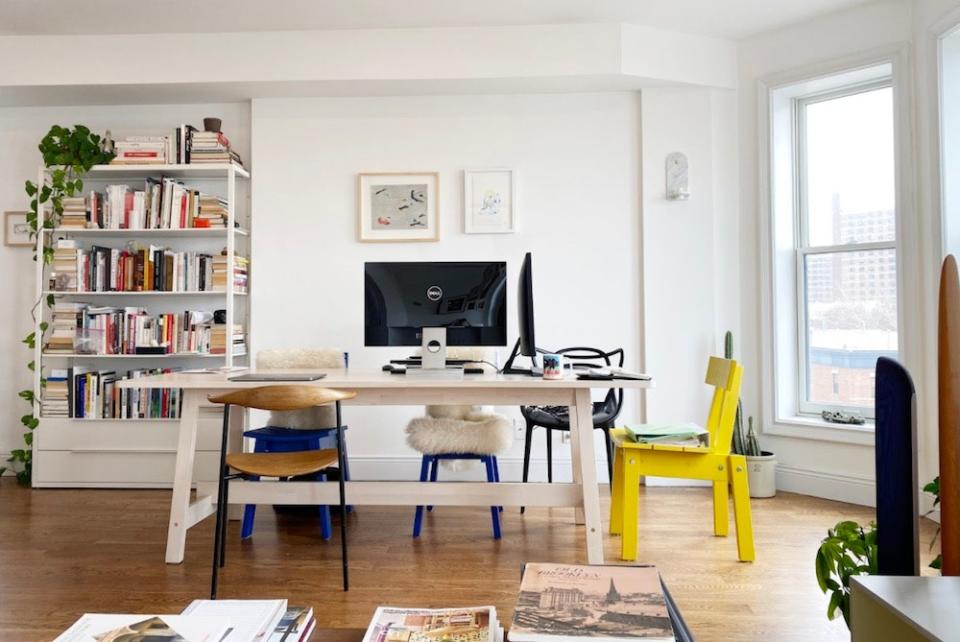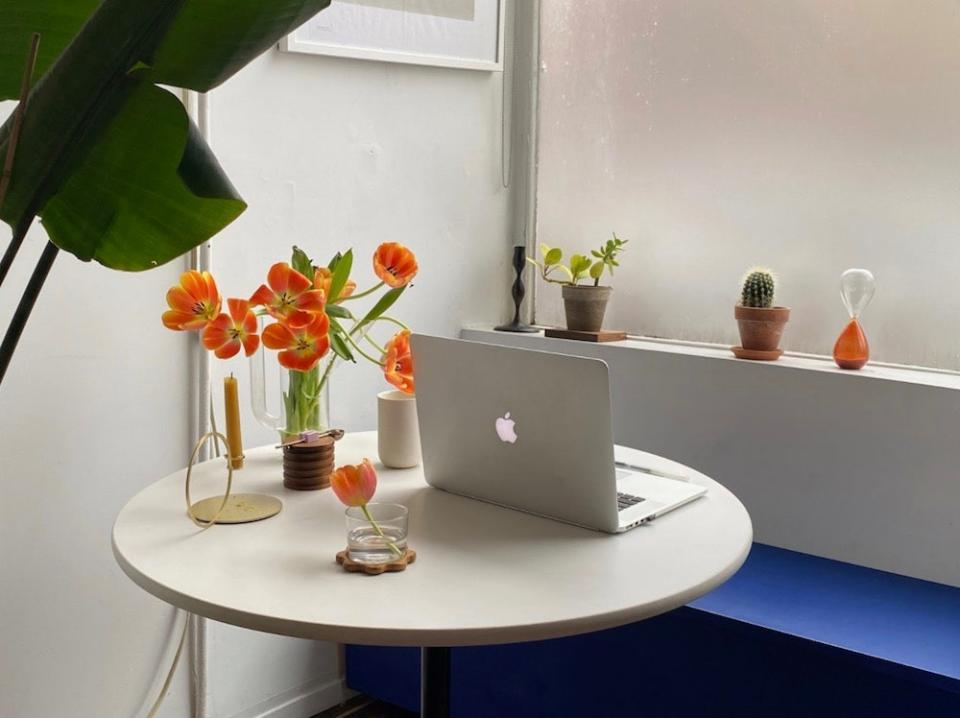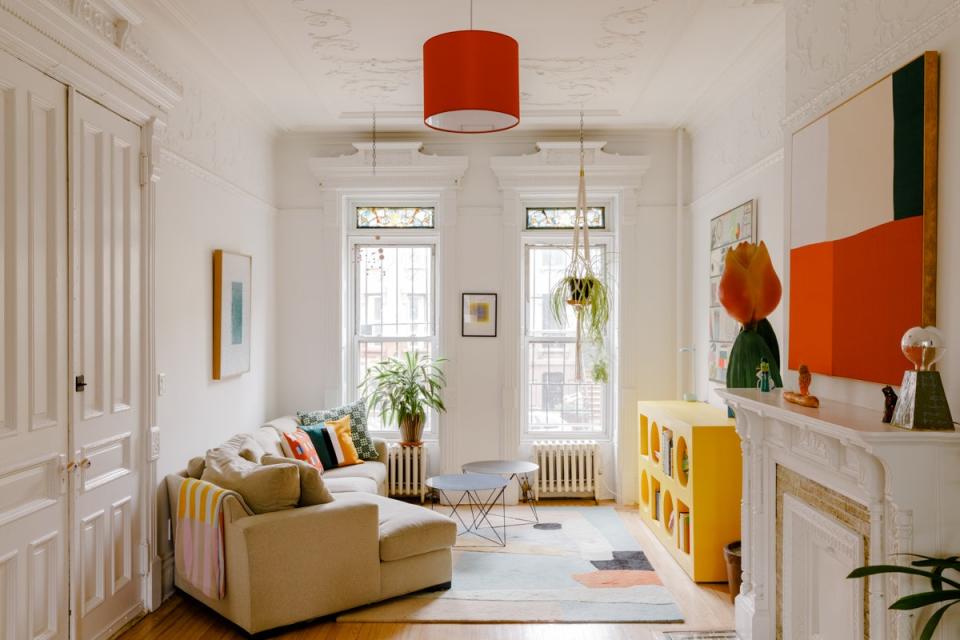How Four Creatives Are Reinventing Their Spaces to WFH
While the phrase “business as usual” is certainly not applicable during this time of intense confusion, worry, and uncertainty, “business gets creative” may be an accurate alternative. As studios close to protect public health and safety, designers are reinventing their own homes as maker spaces—and finding new ways to be inspired within them. Unlike a typical office job, design cannot always be done using just a computer, so many have moved materials, industrial lighting, and even photography equipment temporarily into domiciles to continue–or reimagine–their practice.
“As an artist, self-isolation is an interesting concept—many of us already spend so much time secluded in our studios with nothing but our own thoughts, but now that that isolation is mandated I can’t stop thinking about how deeply I want to share the experience of making things,” says Wife NYC botanical artist and designer Sophie Parker, whose living room has suddenly seen more activity than ever before—now where she paints, arranges, and photographs her work.
But others are not so quick to count on finding a creative spark while isolated. “I think there is a misconception that in these times of panic, creative professionals are having a fine time at home painting pictures, composing, and making art; I am as scared as everyone else, and I am finding it very difficult to think about anything but the current situation,” says designer Karl Zahn, emphasizing the importance of both mental health and physical health during the COVID-19 pandemic. “If being creative is your typical stressor, then creativity is definitely not going to relax you in times of overwhelming outside stress.”
For all, a new workflow was a necessary solution, albeit one that swaps morning walks for commuting, home-cooked meals for power lunches, and Zoom happy hours for grabbing drinks with friends at a bar. Adjusting to a new normal is just that—an adjustment. Here’s how four of our favorite designers are making it work.

Aiden Bowman of Trueing
“The ‘home-office’ was a mess since we had been mostly living at the studio for the last couple of months, so Josh [Metersky, Trueing cofounder] took the time to spruce things up and do some conscious uncoupling with our laundry pile and excess papers, etcetera.”
Creatively, we’re taking the time to make nice-looking meals and refocus on what’s next, planning for when we (eventually) get past what’s to come. Essentially, it’s like ‘business not as usual’! We have a big dining room table that’s been commandeered as a proto-studio—large ugly monitors and all. We’ve been doing lots of sketching for upcoming projects and trying to find creative ways to move forward with things we had planned for the coming months. Ever the decorator, Josh is also moving things around, putting up some new finds, and thinking about how we might get rid of some furniture we don’t want.
It’s odd to try to run the kind of practice we have from home–our materials aren’t really at home in a domestic setting—but it does remind us of early days when we worked from our bedroom. There’s some comfort in knowing (as a designer, or maybe just as a human) that you can really make anything work!”

Sophie Lou Jacobsen
“My boyfriend, Adrian, is also working from home, and we only have one desk and monitor. Because he has a 9-to-5 with a team and lots of video conferencing, he has taken that post, and I set up camp at our little dining table, which isn’t so bad because I have big windows near me, a pretty bouquet of flowers, and closer access to the kitchen. One of our goals is to ‘fake commute’ (go on a walk during the time we’d normally be commuting), but these first few days we’ve kind of just been lavishing in the more lazy mornings.
My greatest challenge at the moment is figuring out ways to disconnect and focus. I’ve realized that I’m not able to sit down and concentrate on work for eight hours straight like I normally do, so I’m trying to work out a new schedule that keeps me off my phone and off reading the news and allows me to be more present when I am sitting down to work.
It’s okay if you aren’t able to treat the pandemic like a mindful retreat. What’s happening is very stressful, and even if we suddenly find ourselves with more time at home, that doesn’t mean we are in the right frame of mind to use that time productively. But I do think that as the weeks progress, we will all settle into new routines out of necessity, and this schedule is just something I’d like to work toward.”

Sophie Parker of Wife NYC
“When it became obvious that we all need to stay inside and do our part to halt the spread of coronavirus, in addition to preparing food and necessities, I knew I would also be rethinking my creative rhythms. My botanical studio @wifenyc is located within a beautiful community of fellow NYC makers, so even though my practice is largely solitary, I needed to swiftly relocate. In a matter of an evening, the living room of my little fourth-floor Brooklyn apartment was looking like a jungle. An eight-foot piece of plywood on a set of steel sawhorses made by my boyfriend, Micah, now sits at one end of the room as a big open worktable. I ripped down the track lighting from the rafters of my studio and hung it overhead. I packed a few boxes of paint and sculpture supplies and commandeered half our bookshelf for storage. In a way it feels more like a living room than ever now because, as they say, ‘Art is life.’ I suppose this is what life looks like now.
The spaces we exist in have so much potential to shape our thoughts and actions. As I set up this new ‘studio’ apartment, I wanted to create something that was not only flexible and adaptable for physically making things, but that also actively creatively encouraged and inspired me when I walked into the space. Designating not only a workspace but also a viewing space for new work is important. Every studio, even a home studio, should have a spot where you can step back and appreciate what you've just made.
As I dive deeper and deeper into making, blurring the boundary between home life and studio life, the ideas begin to flow more freely and inspiration is more abundant. Plants and color have a powerful effect on the human brain that is more essential now than ever. Creatively responding to the natural world and taking time to notice and reflect on its beauty even as we are quarantined indoors is so important.”

Ellen Van Dusen of Dusen Dusen
“I work in a small studio, so I have been going in some days to pack orders and do general maintenance. Generally though, I’m working from my couch. I brought all my tools home, so I have a pretty good setup here. I am going to focus this time on design work and research (whereas in my regular day-to-day I am often dealing with production, logistics, etcetera). Really into the internet right now. And cooking! I planted a bunch of herbs in my kitchen, and it has been weirdly invigorating.
I think these new creative outlets will help me to move everything else forward. I am most inspired when focusing my thoughts outward, and I think being confined in a space allows you the opportunity to get extra creative in finding ways to experience the outside world, which is where new ideas come from. I think after all this is over with, we’ll see some of the best work from designers and artists. Isolation tends to lend itself to strong work, in my opinion.”
Originally Appeared on Architectural Digest

